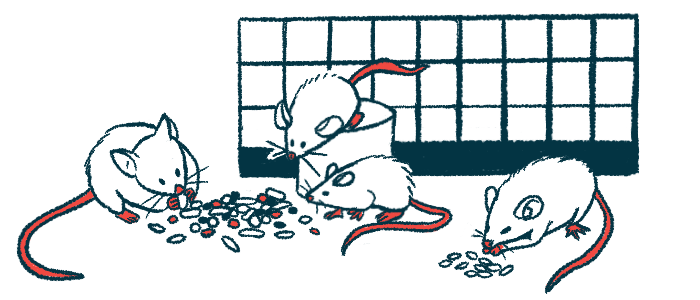GPR75 protein may be fatty liver disease therapeutic target: Study
Mouse studies, human genetic analyses point to treatment potential

Reduced activity of a protein called GPR75 appears to help prevent the buildup of fat in the liver and the subsequent development of metabolic dysfunction-associated steatotic liver disease, or MASLD — previously known as nonalcoholic fatty liver disease.
That’s according to data from mouse models and human genetic analyses that point to GPR75 as a useful treatment target for MASLD, a condition characterized by an abnormal buildup of fat in the liver that can lead to inflammation and permanent scarring, or cirrhosis. The findings were described in the study “Loss of GPR75 protects against non-alcoholic fatty liver disease and body fat accumulation,” which was published in Cell Metabolism.
“Advanced non-alcoholic fatty liver disease can lead to cirrhosis, the only cure of which is a liver transplant,” Lora Heisler, PhD, the study’s senior author and a professor at the Rowett Institute of the University of Aberdeen in the U.K., said in a university press release.
“There are currently no medications to specifically treat this condition,” Heisler said. “This study has highlighted a potential drug target for non-alcoholic fatty liver disease.”
GPR75 may help regulate body fat
The GPR75 protein, coded by a gene of the same name, belongs to a large class of proteins called G-coupled receptors. Little is known about this particular protein, but a 2021 study indicated that people with GPR75 variants resulting in GPR75 loss-of-function tend to have less body fat.
In addition, deleting the GPR75 gene from mice prevented dietary-induced obesity. Together, these findings suggest the protein may help regulate fat storage in the body.
G-coupled receptors are usually pretty easy to target with medications. In fact, “over 30% of medicines act on G protein-coupled receptors,” said Fiona Murray, MD, another study author and a researcher at the university’s Institute of Medical Sciences.
This suggests that GPR75 “could be a druggable new target,” Murray said.
Heisler, Murray, and colleagues in the U.K. and Germany conducted a battery of tests aiming to better understand the biological function of the GPR75 protein.
First, they conducted tests in mice to see which types of cells normally produce this protein. The team found that GPR75 is mostly produced in the brain, especially in certain parts that are thought to help regulate hunger and food intake, implying the protein may help control appetite.
To further investigate this idea, they genetically modified mice to lack a working GPR75 protein. When these mice were fed standard chow, they ate about the same amount as unmodified, healthy mice.
But when mice were given a tastier, high-fat diet — meant to mimic the high amount of fat commonly consumed in certain Western countries, which is linked to a higher risk of MASLD — there were notable differences.
Mice prefer high-fat chow
Healthy mice would overeat the high-fat diet, tending to gain weight and become obese. The GPR75-deficient mice, however, would eat less of the high-fat diet, so they ultimately ended up consuming roughly the same number of calories as they had with standard chow. As a result, these mice tended not to become obese even with the high-fat diet.
“This occurred despite a clear preference for [a high-fat diet] as compared with [standard] chow when given a choice between the two diets, which illustrates that the lowered [high-fat diet] intake is not due to palatability,” the team wrote. “These results indicate that [GPR75-deficient] mice consume an appropriate number of calories to maintain energy balance when provided with a palatable, high-calorie diet,” they wrote. The team noted that these effects were more pronounced in female mice than male mice, but the same trends were seen in both sexes.
Further experiments showed that when mice were kept on a high-fat diet for several months, those lacking GPR75 were significantly less likely to experience the buildup of fat in the liver that typifies MASLD.
The scientists next analyzed data from the U.K. Biobank to investigate GPR75’s potential role in people. With genetic data from more than 428,000 people of European ancestry, the researchers identified 145 people (77 females and 68 males) carrying loss-of-function mutations in the GPR75 gene.
These people with reduced GPR75 function tended to have less body fat relative to those without such GPR75 variants. They also tended to have lower scores on the hepatic steatosis index, a marker of liver fat accumulation.
“These results imply that GPR75 [loss-of-function] carriers have a reduced risk of [fat] accumulation in liver,” the researchers wrote.
“People who enrolled to the UK Biobank were profiled, and we found that those with disruptions in the GPR75 gene were less susceptible to fatty liver disease,” Heisler said, calling the finding “an important breakthrough.”
Similar findings were observed in mice, with animals lacking GPR75 being significantly protected from high-fat diet-induced liver fat accumulation and showing less severe MASLD relative to healthy mice.
“Going forward, we plan to harness our discovery and investigate how we can block GPR75 action in the body to translate our findings [to] the clinic,” and develop new therapies for MASLD and other metabolic conditions, Murray said.



